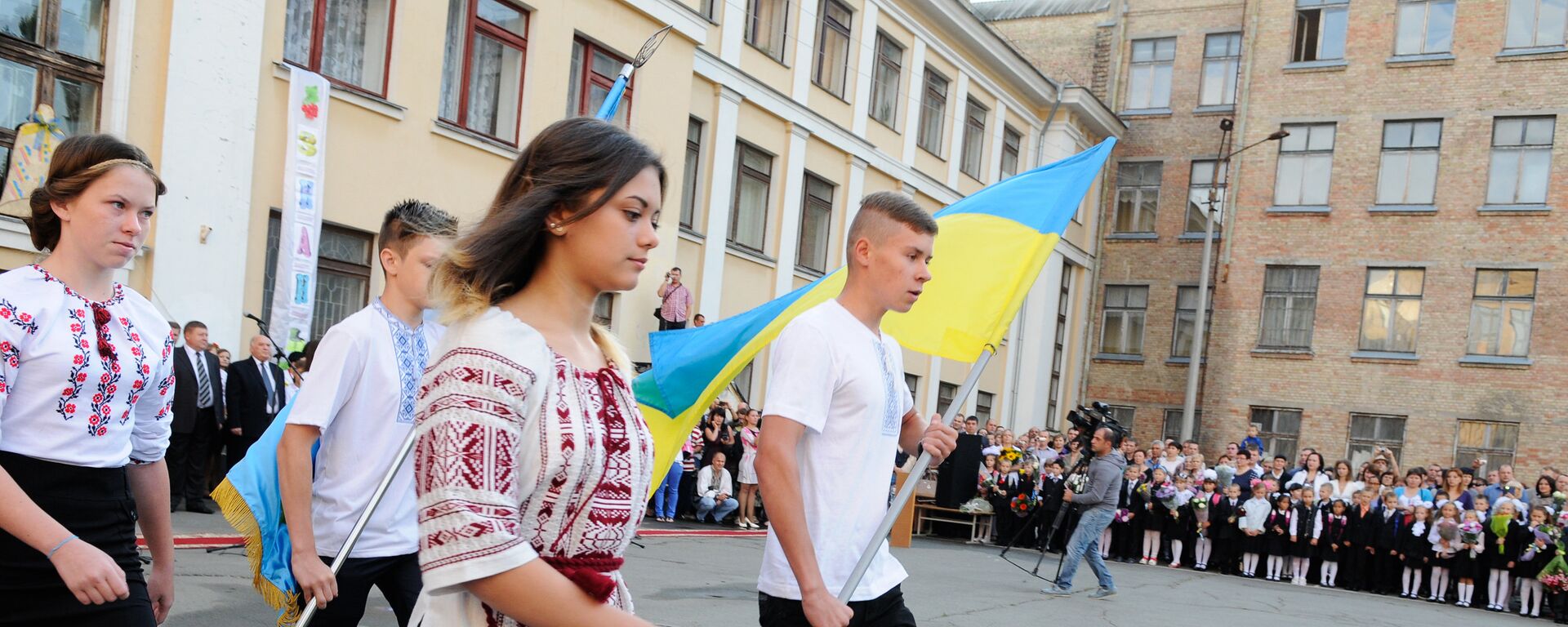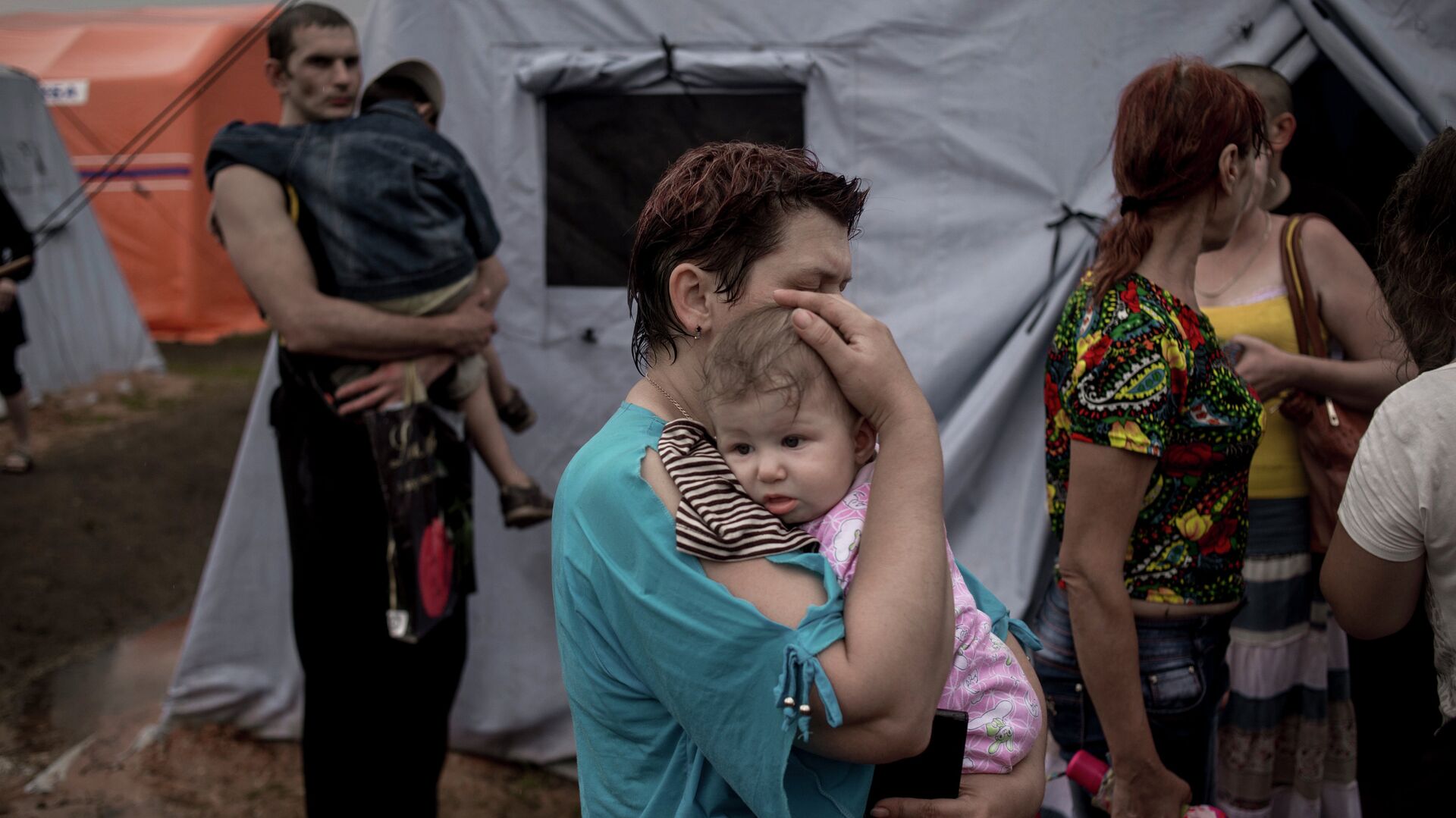https://sputnikglobe.com/20230826/which-eu-countries-have-most-ukrainian-refugees-1112867187.html
Which EU Countries Have Most Ukrainian Refugees?
Which EU Countries Have Most Ukrainian Refugees?
Sputnik International
Europe grapples with an unprecedented influx of over 5.8 million Ukrainian refugees, escaping NATO’s proxy war against Russia in their country, prompting strained resources and swift action from the EU. However, the continent faces the complex task of sheltering and sustaining this displaced population.
2023-08-26T18:55+0000
2023-08-26T18:55+0000
2023-08-26T18:55+0000
filippo grandi
europe
russia
moldova
ukraine
un refugee agency (unhcr)
nato
european union (eu)
slovakia
world
https://cdn1.img.sputnikglobe.com/img/19082/95/190829524_0:160:3076:1890_1920x0_80_0_0_74dc6a89487496b708e47306cb03a2dd.jpg
In less than a month, NATO's proxy war against Russia in Ukraine has prompted over three million people to seek refuge in adjoining countries, predominantly Hungary, Poland, Slovakia, Moldova, and Romania.A significant number have relocated internally - from eastern to western Ukraine. According to Filippo Grandi, the United Nations High Commissioner for Refugees, this is one of the swiftest mass movements witnessed in the last four decades. Currently, most of the affected are women and children, as men are being conscripted, often without proper military training to fight a more advanced Russian Army at the frontlines.Europe has witnessed past refugee crises, but the one happening in Ukraine is distinct because of its scale and momentum. The magnitude and speed of the displacement are clear indicators, but so is the European Union's assessment that this time, it's a unique situation. The closeness of the borders is an evident distinguishing factor.In light of the Ukraine crisis, Europe initially extended open arms, both symbolically and practically. On March 3, 2022, the European Union initiated its temporary protection directive for the first time, allowing fleeing Ukrainians the right to reside, seek employment, and access social benefits in 26 out of its 27 member bloc.Economically speaking, refugees can have a dual impact both as a challenge and a potential asset. In 2022, Goldman Sachs, a leading US financial institution, said that the European Union's top four economies were projected to allocate approximately 0.2 percent of their GDP to assist the incoming refugee population, provided that four million Ukrainian asylum seekers arrive in the region. While this figure might appear modest, it adds to the ongoing crisis-affiliated costs the EU would cater to.Sputnik explores the Ukrainian refugee crisis in Europe and some related financial updates.How Many Ukrainian Refugees Are in Europe?According to UNHCR data, as of August 2023, 5,829,600 refugees from Ukraine have been recorded in Europe. Only four countries featured in the Refugee Response Plan have recorded a refugee population of over 100,000 people. They include:Source: UNHCR (*date is as of the time of writing this piece)Source: UNHCR (*date is as of the time of writing this piece)The Russian Federation has recorded 1,275,315 refugees, with 65,400 people applying for asylum, temporary protection, or similar national plans.Why Do Refugees Opt for Specific Host Countries?Moreover, a survey commissioned by the UNHCR found that refugees with Ukrainian origin found refuge in their host nations as the 2022 conflict erupted. Interestingly, a significant portion, 58 percent, attributed their choice of current host country to its proximity to Ukraine. Reuniting with family and friends (33 percent) followed closely as another key reason. The language spoken in the host country was also identified as a motivating factor by 14 percent of respondents, with a higher ratio in Moldova. Furthermore, nine percent stated that the pursuit of temporary protection prompted their move, while job opportunities enticed eight percent.Does EU Prioritize Ukrainian refugees?Since the commencement of the Ukraine conflict, over 5.8 million Ukrainian refugees have formally documented their presence across Europe. The EU has flung open its borders, extending temporary haven to Ukrainian citizens who find themselves displaced. The EU lifted border restrictions on March 4, 2022 to afford Ukrainians uncomplicated sanctuary. This Temporary Protection Directive allowed Ukrainian refugees to cross into the European Union without requiring a visa or formal asylum filing.How are EU Member Countries Funded to Support Ukrainian Refugees?The bloc has released billions of untapped funds for European regions designated to assist Ukrainian refugees immediately. The Cohesion Fund comprises funding from the European Social Fund and the Fund for European Aid to the Most Deprived. Furthermore, an additional €10 billion from the REACT-EU pandemic recovery initiative is now available.The European Union has endorsed a rule termed CARE: Cohesion’s Action for Refugees in Europe to assist EU countries in handling the immediate and crucial costs of accommodating these refugees. CARE empowers EU member states to use unutilized and unassigned funds totaling several billion euros from the Cohesion Funds 2014-2020 budget.Apart from helping defray the expenses related to temporary housing, food and water provisions, clothing, and bedding, these funds can also be allocated for educational resources, medical and psychological care, training programs, language programs, and childcare.How Do EU Members Coordinate Efforts to Address Ukrainian Refugee Crisis?The European Union Agency for Asylum (EUAA) is an EU institution that assists member states in implementing EU regulations that oversee asylum, international protection, and reception standards, acknowledged as the Common European Asylum System (CEAS).To harmonize the agency's endeavors in providing support to EU member states regarding asylum and accommodation necessities related to Ukraine, the European Asylum Authority (EUAA) inaugurated the Ukraine Emergency Response Board (UERB) on March 7, 2022, and plays a role in executing the Temporary Protection Directive.What is Funding Update Regarding Ukrainian Refugee Crisis?According to the UNHCR's Refugee Response Plan (an inter-agency planning and coordination tool for large-scale or complex refugee situations) targeted at refugees from Ukraine, 25 percent of the funds - $424,466,645 - have been realized out of the needed $1,685,495,254. Source: Refugee Response Financial Tracking, UNHCRSource: Refugee Response Financial Tracking, UNHCRSource: Refugee Response Financial Tracking, UNHCR
https://sputnikglobe.com/20220823/ukraine-refugee-hosts-in-uk-should-get-double-payment-amid-fears-they-will-drop-out-minister-warns-1099893904.html
https://sputnikglobe.com/20221023/berlin-struggles-to-deal-with-influx-of-refugees-from-ukraine-1102547469.html
https://sputnikglobe.com/20220216/researcher-warns-nordic-countries-of-refugee-flow-from-migrant-nation-ukraine-1093070894.html
russia
moldova
ukraine
slovakia
Sputnik International
feedback@sputniknews.com
+74956456601
MIA „Rossiya Segodnya“
2023
Sputnik International
feedback@sputniknews.com
+74956456601
MIA „Rossiya Segodnya“
News
en_EN
Sputnik International
feedback@sputniknews.com
+74956456601
MIA „Rossiya Segodnya“
Sputnik International
feedback@sputniknews.com
+74956456601
MIA „Rossiya Segodnya“
ukraine refugee crisis, nato proxy war, european refugee crisis, unhcr data, displacement, european union, temporary protection directive, refugee population, economic impact, goldman sachs, cohesion fund, react-eu, care program, eu member states, european union agency for asylum, funding update, refugee response plan, funding donors, asylum seekers, asylum applications, eu regulations, common european asylum system, ukraine emergency response board, inter-agency planning, financial tracking, humanitarian aid, hungary, poland, slovakia, moldova, romania, czech republic, germany, united kingdom, spain, italy, european union member countries, united states of america, japan, norway, france, switzerland, sweden, denmark, canada, netherlands, liechtenstein, russia, republic of korea, new zealand, israel, lithuania, bulgaria, latvia, estonia.
ukraine refugee crisis, nato proxy war, european refugee crisis, unhcr data, displacement, european union, temporary protection directive, refugee population, economic impact, goldman sachs, cohesion fund, react-eu, care program, eu member states, european union agency for asylum, funding update, refugee response plan, funding donors, asylum seekers, asylum applications, eu regulations, common european asylum system, ukraine emergency response board, inter-agency planning, financial tracking, humanitarian aid, hungary, poland, slovakia, moldova, romania, czech republic, germany, united kingdom, spain, italy, european union member countries, united states of america, japan, norway, france, switzerland, sweden, denmark, canada, netherlands, liechtenstein, russia, republic of korea, new zealand, israel, lithuania, bulgaria, latvia, estonia.
In less than a month,
NATO's proxy war against Russia in Ukraine has prompted over three million people to seek refuge in adjoining countries, predominantly
Hungary, Poland, Slovakia, Moldova, and Romania.
A significant number have relocated internally - from eastern to western Ukraine. According to Filippo Grandi, the United Nations High Commissioner for Refugees, this is one of the swiftest mass movements witnessed in the last four decades. Currently, most of the affected are women and children, as men are being conscripted, often without proper military training to fight a more advanced Russian Army at the frontlines.
Europe has witnessed past refugee crises, but the one happening in Ukraine is distinct because of its scale and momentum. The magnitude and speed of the displacement are clear indicators, but so is the European Union's assessment that this time, it's a unique situation. The closeness of the borders is an evident distinguishing factor.
In light of the Ukraine crisis, Europe initially extended open arms, both symbolically and practically. On March 3, 2022, the European Union initiated its temporary protection directive for the first time, allowing fleeing Ukrainians the right to reside, seek employment, and access social benefits in 26 out of its 27 member bloc.

23 August 2022, 12:06 GMT
Economically speaking, refugees can have a dual impact both as a challenge and a potential asset. In 2022, Goldman Sachs, a leading US financial institution, said that the European Union's top four economies were projected to allocate approximately 0.2 percent of their GDP to assist the incoming refugee population, provided that four million Ukrainian asylum seekers arrive in the region. While this figure might appear modest, it adds to the ongoing crisis-affiliated costs the EU would cater to.
Sputnik explores the Ukrainian refugee crisis in Europe and some related financial updates.
How Many Ukrainian Refugees Are in Europe?
According to UNHCR data, as of August 2023, 5,829,600 refugees from Ukraine have been recorded in Europe. Only four countries featured in the Refugee Response Plan have recorded a refugee population of over 100,000 people. They include:
Top 4 Countries Featured in the Refugee Response Plan
Countries | Number of Refugees | Number of Refugees who filed for Asylum, Temporary Protection or national protection schemes |
Poland | 968,390 | 1,639,725 |
Czech Republic | 363,195 | 549,645 |
Republic of Moldova | 117,160 | 3,195 |
Slovakia | 106,935 | 124,295 |
Source: UNHCR (*date is as of the time of writing this piece)
Top 4 Other European Countries Haboring Refugees from Ukraine
Countries | Number of Refugees | Number of Refugees who filed for Asylum, Temporary Protection or national protection schemes |
Germany | 1,084,410 | 972,795 |
United Kingdom | 210,800 | 1,200 |
Spain | 186,045 | 187,695 |
Italy | 167,210 | 186,615 |
Source: UNHCR (*date is as of the time of writing this piece)
The Russian Federation has recorded 1,275,315 refugees, with 65,400 people applying for asylum, temporary protection, or similar national plans.
Why Do Refugees Opt for Specific Host Countries?
Moreover, a survey commissioned by the UNHCR found that refugees with Ukrainian origin found refuge in their host nations as the 2022 conflict erupted. Interestingly, a significant portion, 58 percent, attributed their choice of current host country to its proximity to Ukraine. Reuniting with family and friends (33 percent) followed closely as another key reason. The language spoken in the host country was also identified as a motivating factor by 14 percent of respondents, with a higher ratio in Moldova. Furthermore, nine percent stated that the pursuit of temporary protection prompted their move, while job opportunities enticed eight percent.

23 October 2022, 12:09 GMT
Does EU Prioritize Ukrainian refugees?
Since the commencement of the Ukraine conflict,
over 5.8 million Ukrainian refugees have formally documented their presence across Europe. The EU has flung open its borders, extending temporary haven to Ukrainian citizens who find themselves displaced. The EU lifted border restrictions on March 4, 2022 to afford Ukrainians uncomplicated sanctuary. This
Temporary Protection Directive allowed Ukrainian refugees to cross into the European Union without requiring a visa or formal asylum filing.
How are EU Member Countries Funded to Support Ukrainian Refugees?
The bloc has released billions of untapped funds for European regions designated to assist Ukrainian refugees immediately. The
Cohesion Fund comprises funding from the
European Social Fund and the
Fund for European Aid to the Most Deprived. Furthermore, an additional €10 billion from the
REACT-EU pandemic recovery initiative is now available.
The European Union has endorsed a rule termed CARE: Cohesion’s Action for Refugees in Europe to assist EU countries in handling the immediate and crucial costs of accommodating these refugees. CARE empowers EU member states to use unutilized and unassigned funds totaling several billion euros from the Cohesion Funds 2014-2020 budget.
Apart from helping defray the expenses related to temporary housing, food and water provisions, clothing, and bedding, these funds can also be allocated for educational resources, medical and psychological care, training programs, language programs, and childcare.

16 February 2022, 05:03 GMT
How Do EU Members Coordinate Efforts to Address Ukrainian Refugee Crisis?
The European Union Agency for Asylum (EUAA) is an EU institution that assists member states in implementing EU regulations that oversee asylum, international protection, and reception standards, acknowledged as the Common European Asylum System (CEAS).
To harmonize the agency's endeavors in providing support to EU member states regarding asylum and accommodation necessities related to Ukraine, the European Asylum Authority (EUAA) inaugurated the Ukraine Emergency Response Board (UERB) on March 7, 2022, and plays a role in executing the Temporary Protection Directive.
What is Funding Update Regarding Ukrainian Refugee Crisis?
According to the UNHCR's Refugee Response Plan (an inter-agency planning and coordination tool for large-scale or complex refugee situations)
targeted at refugees from Ukraine, 25 percent of the funds - $424,466,645 - have been realized out of the needed $1,685,495,254.
Fund Donors
Donor Standard | Funds Received (in $) |
Others | $347,044,698 |
United States of America | $20,150,680 |
Japan | $16,556,296 |
Norway | $14,668,642 |
Germany | $10,848,792 |
France | $3,705,007 |
Hungary | $2,795,116 |
Switzerland | $2,284,467 |
Sweden | $1,885,619 |
United Kingdom | $1,841,863 |
Denmark | $1,463,115 |
Canada | $941,005 |
Netherlands | $929,423 |
Liechtenstein | $100,000 |
Republic of Korea | $90,447 |
New Zealand | $66,824 |
Israel | $48,269 |
Lithuania | $20,000 |
Slovakia | $11,200 |
Received Funds and Gap by Country
Target Countries | Funds Received (in $) | Funding Gap (in $) |
Poland | $109,605,456 | $599,793,984 |
Moldova | $150,275,700 | $276,686,199 |
Romania | $57,787,631 | $95,816,269 |
Czech Republic | $11,995,614 | $69,582,674 |
Slovakia | $18,421,190 | $61,704,883 |
Regional & Others | $39,633,746 | $49,123,835 |
Hungary | $16,649,099 | $46,092,700 |
Bulgaria | $13,338,966 | $30,048,292 |
Lithuania | $3,328,793 | $14,484,666 |
Latvia | - | $10,336,875 |
Estonia | - | $7,358,232 |
Received Funds and Gap by Sector
Target Sectors | Funds Received (in $) | Funding Gap (in $) |
Basic Needs | $177,918,534 | $560,262,961 |
Protection | $129,601,579 | $301,213,203 |
Livelihood & Resilience | $33,675,330 | $145,688,549 |
Education | $36,652,350 | $136,522,988 |
Health & Nutrition | $24,168,297 | $127,507,623 |
Operational Support | $3,495,952 | $9,787,888 |
Multi-sectors | $19,954,603 | - |





